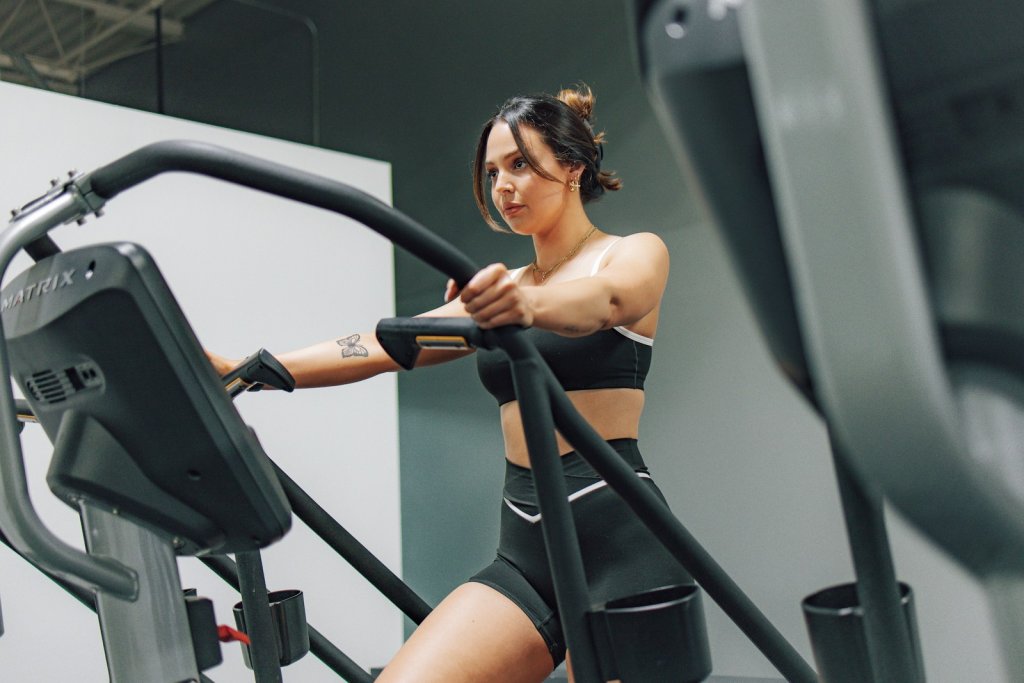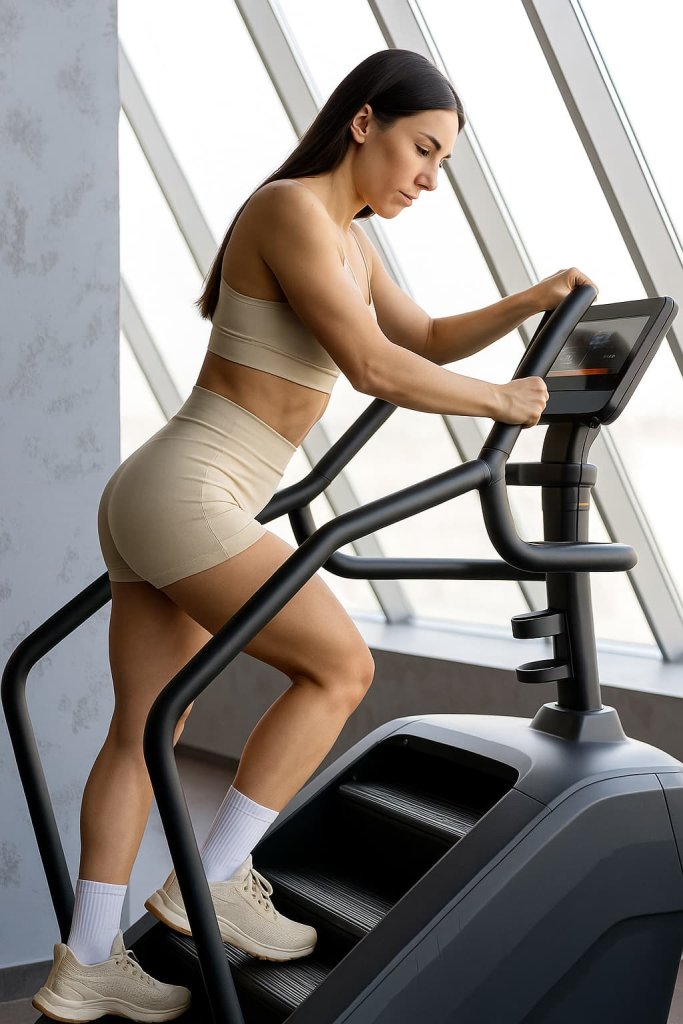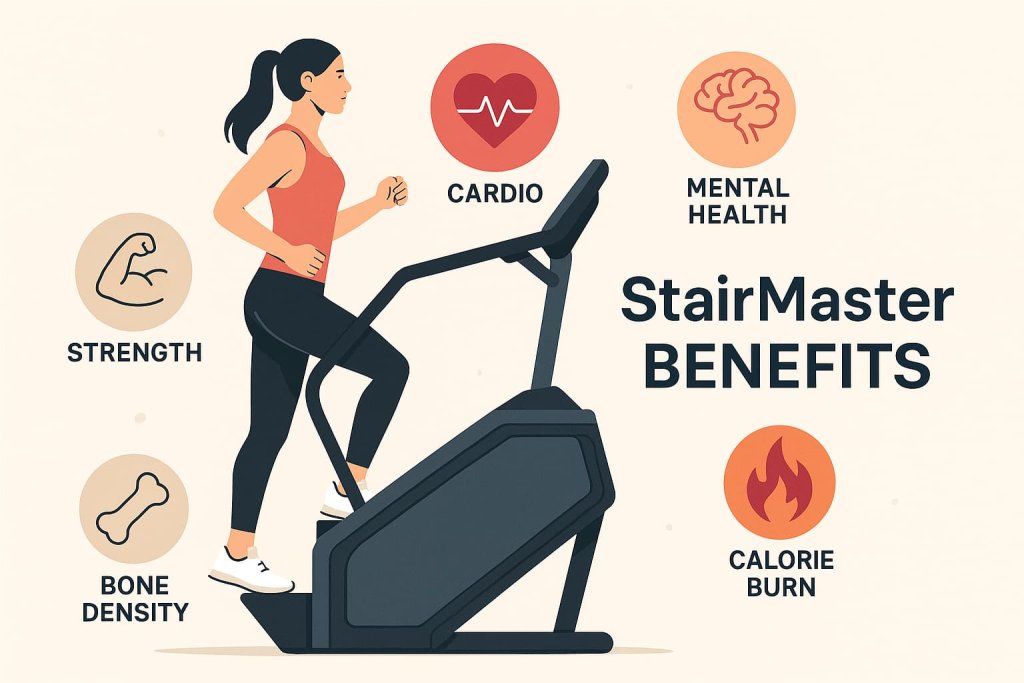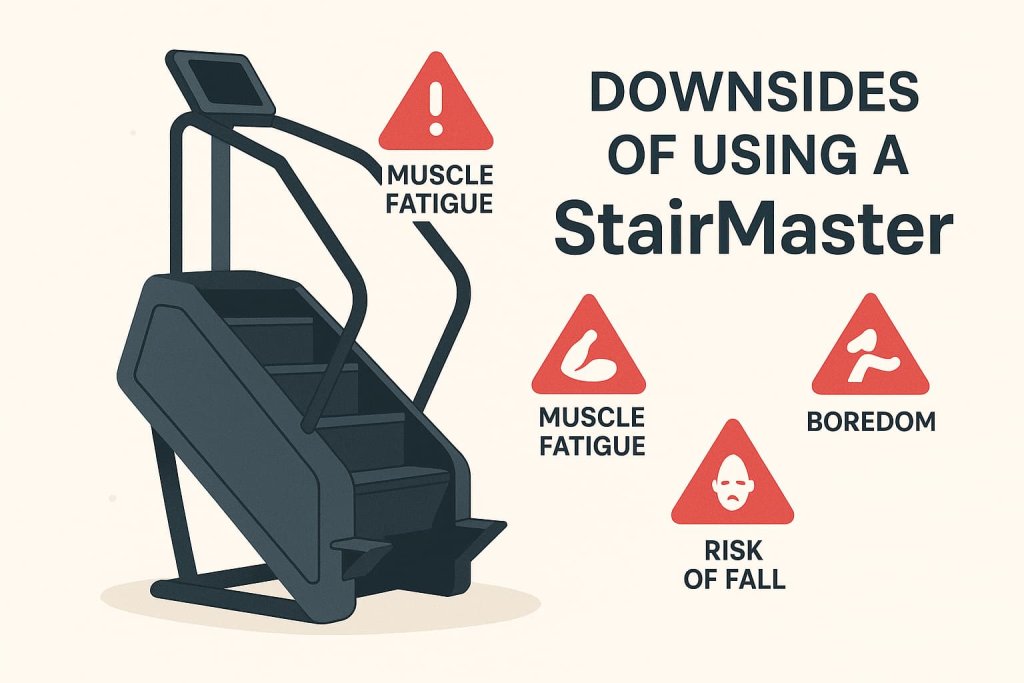Yes, the StairMaster is one of the most effective cardio machines, delivering science-backed benefits for your heart, muscles, and overall health. Research shows that stair climbing can significantly improve cardiovascular fitness, strengthen the lower body, and support long-term wellness.

Understanding StairMaster benefits is important because it combines the intensity of climbing stairs with the convenience of a gym machine. In just 20–30 minutes, you can burn calories, improve endurance, and tone your legs—all without the high impact of running.
In this guide, we’ll break down the top 15 StairMaster benefits backed by science, explore its potential downsides, share safety tips, and answer common FAQs so you can decide if it’s the right workout for you.
What Is a StairMaster?

A StairMaster is a cardio fitness machine that simulates the action of climbing a continuous flight of stairs. It’s designed to provide a low-impact, high-intensity workout that challenges your heart, lungs, and muscles at the same time. Unlike treadmills, which focus mainly on forward walking or running, the StairMaster emphasizes vertical stepping against resistance.
Most StairMaster machines come in two main designs:
- StepMill (stair-climbing machine): Features a rotating set of steps that mimic an endless staircase. It feels most like climbing real stairs.
- Stair Stepper (pedal-style): Uses two pedals that move up and down, requiring you to push against resistance with each step.
Both versions effectively target the lower body muscles—especially the quadriceps, hamstrings, calves, and glutes—while also engaging the core to maintain balance.
👉 Fitness experts note that the StairMaster is a unique cardio machine because it blends aerobic training (improving endurance and heart health) with strength-endurance training for the legs.
Top Benefits of Using a StairMaster

The StairMaster combines cardio and strength training in one workout, making it a highly efficient exercise machine. Below are the science-backed benefits that show why it deserves a spot in your fitness routine.
1. Boosts Cardiovascular Fitness
One of the greatest benefits of using a StairMaster is its powerful impact on cardiovascular health. Because you’re constantly moving against gravity, your heart and lungs are forced to work harder. This results in stronger cardiac muscles, improved circulation, and greater oxygen delivery throughout the body.
Research published in the British Journal of Sports Medicine found that women who performed a 9-week stair climbing program improved their VO₂ max (a gold standard measure of aerobic capacity) by up to 12% (PubMed). Improved VO₂ max means your body is more efficient at using oxygen during workouts, translating into greater endurance for both exercise and daily activities.
👉 In practical terms, climbing stairs regularly makes it easier to walk long distances, carry groceries, or take on sports without getting winded.
2. Builds Lower Body Strength
The StairMaster targets some of the largest and most powerful muscles in your body—quads, hamstrings, glutes, and calves. With each step, you engage these muscles in a controlled, repetitive motion that builds both strength and muscular endurance.
According to Healthline, this makes the StairMaster a unique cardio machine because it doubles as a strength workout. Over time, stronger legs translate to improved walking and running performance, reduced injury risk, and better balance.
👉 Athletes often use stair workouts to build explosive lower body power, while beginners benefit from increased stamina in everyday activities like climbing real stairs or standing for long periods.
3. Improves Bone Density
Because the StairMaster is a weight-bearing activity, it provides stress to your bones in a healthy way, encouraging them to adapt and grow stronger. This is particularly important as we age, since bone loss increases the risk of fractures and osteoporosis.
The Cleveland Clinic notes that activities like stair climbing help stimulate osteoblast activity, which promotes bone formation. Combined with resistance training and proper nutrition (calcium + vitamin D), StairMaster workouts can help maintain bone health long-term.
👉 This makes it an excellent choice for postmenopausal women and older adults who want to preserve mobility and independence.
4. Burns More Calories in Less Time
The StairMaster is one of the most efficient calorie-burning machines in the gym. Because every step requires lifting your body weight upward, you burn more calories compared to flat walking.
A 30-minute session can burn 200–400 calories, depending on body weight and intensity (Cleveland Clinic). That means you can achieve the same calorie burn in less time compared to many other cardio exercises.
👉 For anyone focused on weight loss or fat burning, the StairMaster is a time-saving solution that supports calorie deficit while building strength.
5. Protects Joints Compared to Running
Running is high-impact and can stress the knees, hips, and ankles, especially on hard surfaces. In contrast, stair climbing is low-impact but still provides high intensity. This makes it suitable for people who want cardio without the pounding effects of running.
👉 It’s particularly helpful for beginners, overweight individuals, or those returning from injury who need a safer way to improve cardiovascular fitness.
6. Enhances Core Stability and Balance
Unlike treadmills, the moving stairs on a StairMaster require constant core activation to maintain posture and stability. Over time, this strengthens your abdominal and back muscles, leading to improved posture and reduced risk of lower back pain.
Health.com points out that stabilizing your body on the StairMaster improves balance and coordination, which carries over into everyday activities such as walking on uneven ground or climbing actual stairs safely.
7. Improves Blood Pressure and Cholesterol
Cardio exercise like stair climbing is proven to support heart health beyond fitness gains. Research shows it lowers blood pressure, reduces harmful LDL cholesterol, and improves insulin sensitivity, which reduces the risk of type 2 diabetes.
A review published in the Journal of Preventive Medicine & Public Health found that stair interventions had significant effects on blood pressure, lipid profile, and glucose metabolism (PMC).
👉 Adding even short bursts of stair climbing to your weekly routine can provide lasting benefits for cardiovascular health.
8. Efficient for Busy Schedules
Not everyone has an hour to spend at the gym, and that’s where the StairMaster shines. Even 10 minutes a day of stair intervals can significantly improve cardiovascular fitness, as shown in short-term intervention studies.
Because it combines cardio, strength, and calorie burn in one session, it’s a time-efficient workout for busy professionals, parents, and students.
👉 For best results, aim for high-intensity intervals (e.g., 1 minute fast climbing, 2 minutes easy pace) for maximum benefit in minimum time.
9. Supports Cardiac Rehabilitation
Stair climbing is also being used as a safe and effective option for people recovering from heart problems. A study published on ScienceDaily highlighted how stair climbing workouts improved cardiovascular function and muscular endurance in patients post-heart surgery or with coronary artery disease.
👉 Of course, this should always be done under medical supervision, but it shows how versatile and safe the StairMaster can be when scaled properly.
10. Extends Longevity
Exercise habits directly affect how long and how well we live. A large 2024 meta-analysis published in Sports Medicine found that people who regularly climbed stairs had a significantly lower risk of all-cause and cardiovascular mortality (Springer).
👉 Simply put, climbing stairs today can add healthy years to your life tomorrow.
11. Strengthens Hip Extension & Mobility
The repetitive upward stepping motion promotes hip extension, an often neglected movement in modern sedentary lifestyles. Limited hip extension can contribute to poor posture, lower back pain, and reduced athletic performance.
Regular StairMaster sessions keep hips mobile and strong, improving overall body mechanics and making everyday tasks (like bending, squatting, or standing up) easier.
12. Boosts Mental Health
Exercise is medicine for the mind, and stair climbing is no exception. Like other aerobic activities, StairMaster workouts trigger the release of endorphins and serotonin, which elevate mood and reduce stress.
Healthline notes that regular aerobic exercise is linked to decreased symptoms of anxiety and depression, and even improved cognitive performance over time.
👉 Just 15–20 minutes on the StairMaster can leave you feeling calmer, more focused, and energized.
13. Improves Coordination & Neuromuscular Control
Climbing a moving staircase demands rhythm, timing, and balance. Over time, this enhances neuromuscular efficiency, meaning your brain and muscles communicate more effectively.
This has real-world benefits: fewer falls, smoother movements, and better athletic coordination. For older adults, it’s a valuable way to reduce fall risk while maintaining independence.
14. Enhances Athletic Performance
Runners, soccer players, and basketball athletes use stair workouts for cross-training. Stair climbing builds leg strength, power, and endurance in ways that complement other training.
Runner’s World highlights that runners who include stair workouts improve uphill running efficiency, stride power, and overall stamina.
👉 Even if you’re not an athlete, this translates to better performance in recreational sports or high-energy activities like hiking.
15. Encourages Everyday Movement
One of the simplest but most powerful benefits is how stair climbing integrates into daily life. Choosing stairs over elevators is a practical way to break up sedentary behavior, which research links to better long-term health outcomes.
A review published in Sports Medicine confirms that habitual stair climbing reduces risks of chronic disease and mortality (Springer).
Downsides of Using a StairMaster

While the StairMaster delivers impressive fitness benefits, it’s not without its drawbacks. Here are the main downsides you should know:
1. Knee and Joint Stress
Although often called “low impact,” the repetitive climbing motion still places significant stress on the knees, hips, and ankles. People with pre-existing joint issues may experience discomfort or flare-ups if they overdo it. (BarBend)
Tip: Start slow, focus on proper form, and avoid leaning heavily on the handrails.
2. Limited Upper Body Workout
The StairMaster mainly trains the lower body (quads, glutes, hamstrings, calves) and core. It provides little engagement for the arms, chest, or back. If you want a full-body routine, you’ll need to pair it with strength training. (PureGym)
3. Muscle Fatigue Before Cardio Capacity
Because your legs do most of the work, lower body muscles often fatigue before your cardiovascular system is fully challenged. Beginners may find their legs burning out after just a few minutes. (FitBod)
4. Risk of Trips or Falls
The moving steps can be tricky, especially at higher speeds. Missteps, distractions, or fatigue can lead to stumbles or falls. Always keep focus and use handrails lightly for balance when needed.
5. Monotony Factor
Some people find stair climbing monotonous compared to varied workouts like treadmill intervals or outdoor running. The repetitive motion can feel boring if you don’t change intensity or add interval training. (GQ Magazine)
6. Steep Learning Curve
The StairMaster can be tough for beginners. Its intensity often feels harder than walking or treadmill running, and sustaining a long workout can be challenging.
7. Potential Overuse Injuries
Relying solely on the StairMaster may cause muscular imbalances (overdeveloped quads, tight hip flexors) or overuse injuries. It’s best used as part of a balanced fitness program.
8. Calorie Burn Estimates May Be Misleading
The digital readouts on cardio machines often overestimate calorie burn. StairMaster sessions are effective, but actual results vary by body weight, intensity, and consistency.
✅ Bottom line: The StairMaster is safe and highly effective when used correctly, but it’s not perfect for everyone. By moderating intensity, mixing workouts, and maintaining good form, you can avoid most downsides.
How to Use a StairMaster Safely
While the StairMaster is an excellent cardio and strength tool, it can be physically demanding. Using it correctly helps you maximize benefits and minimize the risk of injury.
1. Start With Proper Warm-Up
Always warm up for 3–5 minutes with light movement—like walking or dynamic stretches—before stepping onto the StairMaster. This prepares your joints and muscles for the climbing motion.
2. Maintain Good Posture
- Keep your chest up and shoulders relaxed.
- Engage your core to stay upright.
- Avoid leaning heavily on the handrails; use them only for light balance.
👉 Leaning reduces workout effectiveness and can place strain on wrists and shoulders.
3. Start Slow and Build Intensity
Beginners should start at a slow to moderate pace (Level 3–5 on most machines) for 5–10 minutes. Gradually increase time and resistance as fitness improves. Jumping into high-intensity levels too quickly can cause fatigue or knee strain.
4. Use Short, Controlled Steps
Take smaller, controlled steps rather than exaggerated high ones. Overstriding can increase pressure on the knees and lower back. Controlled movement is safer and more effective for endurance.
5. Monitor Breathing and Heart Rate
Stay within your target heart rate zone to avoid overexertion. If you’re gasping for breath after just a minute, slow down. Most gyms have StairMasters with built-in monitors to help track effort.
6. Wear Proper Footwear
Supportive athletic shoes with cushioned soles are essential to reduce joint stress and prevent slips. Avoid flat or worn-out shoes.
7. Listen to Your Body
Stop immediately if you feel sharp pain, dizziness, or excessive knee discomfort. The workout should challenge your endurance, not cause pain.
8. Incorporate Recovery
Allow at least 1 rest day between intense StairMaster workouts to give muscles and joints time to recover. Overuse can lead to strains or tendonitis.
Who Should Avoid the StairMaster?
The StairMaster is safe and effective for most people, but there are certain groups who should use caution—or avoid it entirely—unless cleared by a healthcare professional.
1. People With Serious Knee or Hip Problems
Because stair climbing places repeated load on the knees and hips, those with conditions like advanced osteoarthritis, meniscus injuries, or hip degeneration may find the StairMaster painful. High resistance or long sessions could worsen joint stress.
👉 A physical therapist can recommend alternative low-impact exercises such as swimming, elliptical training, or cycling.
2. Individuals With Balance Issues
The moving steps require coordination and stability. Anyone with poor balance, vertigo, or neurological conditions may be at higher risk of tripping or falling.
👉 In these cases, using a pedal-based stair stepper (with handles) or seated cardio machines (like a recumbent bike) may be safer.
3. People Recovering From Lower Body Injuries
If you are recovering from an ankle sprain, ACL surgery, hip replacement, or other lower-body injury, stair climbing can strain healing tissues. Jumping into intense sessions too soon increases the risk of re-injury.
👉 Consult with a doctor or physical therapist before returning to stair workouts.
4. Those With Uncontrolled Heart Conditions
Since the StairMaster rapidly elevates heart rate, people with uncontrolled hypertension, arrhythmias, or recent cardiac events should avoid it until cleared by a cardiologist.
👉 Cardiac patients often benefit from supervised rehab programs with modified stair exercises (ScienceDaily).
5. Pregnant Women (In Some Cases)
Many women can exercise safely during pregnancy, but the StairMaster may feel uncomfortable in later stages due to balance shifts, joint laxity, and fatigue.
👉 Safer alternatives include brisk walking, swimming, or prenatal fitness classes—always with medical guidance.
✅ Bottom line: If you have joint pain, balance challenges, recent injuries, or heart conditions, check with a healthcare provider before using the StairMaster. For everyone else, it can be a safe, effective tool when used correctly.
FAQs About StairMaster Benefits
1. How long should I use the StairMaster for best results?
Beginners can start with 10–15 minutes, 3 times a week. As fitness improves, aim for 20–30 minutes, 4–5 times a week. Consistency matters more than duration.
2. Does the StairMaster burn belly fat?
Yes—indirectly. The StairMaster helps create a calorie deficit, which reduces overall body fat, including belly fat. However, no machine can target fat loss from one specific area.
3. Is the StairMaster better than a treadmill?
It depends on your goals. The StairMaster builds lower body strength and endurance while burning lots of calories. The treadmill allows for varied speeds and inclines and may feel more natural. For joint comfort and calorie burn efficiency, many prefer the StairMaster.
4. Can seniors use the StairMaster?
Yes, but only at a safe speed and resistance. Seniors should start with short sessions and consider a pedal-based stair stepper instead of a moving StepMill to reduce fall risk. Consulting a doctor first is recommended.
5. Is StairMaster good for weight loss?
Absolutely. A 30-minute StairMaster session can burn 200–400 calories, depending on body weight and intensity. When combined with a healthy diet, it supports effective fat loss.
6. Can StairMaster replace leg day?
Not entirely. While it strengthens the quads, hamstrings, glutes, and calves, it doesn’t replace targeted resistance training for maximum strength and muscle growth. It’s best used as a cardio and endurance supplement.
7. Is StairMaster safe for people with bad knees?
It depends on the severity of the condition. Many people with mild knee pain tolerate StairMaster workouts better than running. But those with advanced knee arthritis or injuries should use caution and consult a doctor.
Conclusion
The StairMaster is more than just a cardio machine—it’s a science-backed, full-body fitness tool that improves cardiovascular endurance, strengthens the lower body, boosts bone density, and even enhances mental health. It’s also efficient, making it ideal for busy schedules.
That said, it’s not for everyone. People with knee problems, balance issues, or certain medical conditions should approach it with caution. Used correctly and safely, the StairMaster can become one of the most effective workouts in your routine.
👉 If your goal is to burn calories, build strength, and improve heart health in less time, adding the StairMaster to your weekly workout plan could be a game-changer.
